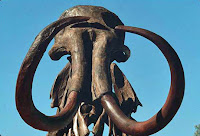 Today the only place to see woolly mammoths and people side-by-side is on The Flintstones or in the movies.
Today the only place to see woolly mammoths and people side-by-side is on The Flintstones or in the movies. But researchers are on the verge of piecing together complete genomes of long-dead species such as Neandertals and mammoths.
So now the big question is, Will we soon be able to bring such extinct species back to life?
Researchers are divided over how they might try to do this and whether it's even feasible.
At the core of this issue is DNA, which encodes the thousands of genes that tell cells how to build themselves and keep running.
Researchers already have deciphered the complete gene sequences—or genomes—for many living species, including humans, dogs, and mice.
The DNA of long-extinct species can also be preserved—in bones or bodies found in dry caves or inside ice, for example.
"Retrieval of DNA from ancient specimens is relatively easy now," said Alan Cooper, of the University of Adelaide in Australia.
Even though such DNA has degraded into thousands of small pieces, researchers can still read these fragments and piece together much of the original genetic instructions.
So many researchers think that assembling the genome of Neandertals (often spelled "Neanderthals") or mammoths is just around the corner.
Link & Image: National Geographic
Tags: Mammoth | DNA | Genomes
Comments